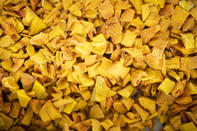Mango (Mangifera indica L.) is the national fruit of India, Pakistan, and the Philippines. It grows well in subtropical areas including some areas in South Africa.

The mango grows on a medium to large, approximately 9 to 35 m, evergreen tree that belongs to the cashew family Anacardiaceae.
Green mangoes are used for salt or oil pickling, curries, chutneys and dehydrated products, while sweet, ripe mangoes are used for canning, juice, puree and drying. The oil-rich kernels can be eaten, used in medicinal applications, for animal feed and for oil.
History of Mango Production
Horticulturists and historians agree that the mango originated in India. Ancient literature and in Indian folklore, there are plenty of stories relating to the mango tree. A popular tale involves a faithful follower who gave Buddha a mango orchard so he could rest in the shade of a mango tree.
The great Mogul Emperor, Akbar, who ruled from 1556 to 1605 had an orchard of 100 000 mango trees. These were huge, even by modern standards.
When the Portuguese settled in Western India, they also called the fruit ‘manga’, probably derived from the Tamil word ‘manga’. From India, the fruit spread westwards, possibly by traders and European colonists. The first commercial plantings in the West was established by Portuguese settlers in Brazil in the 1700s.
In South Africa, the first mangoes were planted by Jan van Riebeeck in Cape Town but the coastal climate proved unsuitable. Some mango plantings in the warmer KwaZulu-Natal was established during the late 1850s. However, commercial plantings only started in earnest during 1920 in the Ofcolaco area, which is near Tzaneen in Limpopo Province and Malelane in Mpumalanga Province.
Mango cultivars: Peach and Sabre, were the first planted in South Africa. The cultivars Kent and Zill were introduced around 1954 and led to a growth in production after 1960 in Ofcolaco, theLetsitele Valley, and in the Letaba areas when it was found that these two cultivars produced good yields in these areas.
Benefits of Mangoes

Mangoes contain high amounts of water - approximately 72 to 86%, carbohydrates - approximately 9 to 25%, and it is low in protein at an estimation of 0.9 - 5.1%, while fat reflects 0.2 - 2.7%.
Mangoes contains a variety of phytochemicals and nutrients. It is high in dietary fibre, vitamin C, provitamin A, and it contains up to 10% of the daily requirement of vitamin B6 as well as carotenoids and polyphenols.
Mango polyphenols work mainly as antioxidants that protect human cells against DNA damage and many degenerative diseases. The potential of the polyphenol mangiferin to combat degenerative diseases like heart diseases and cancer has been extensively demonstrated.
One cup of mango is also an excellent source of folate and copper, supplying up to 20% and 10%, respectively, of an adult's daily needs.
Mango Allergies
The mango belongs to the cashew family Anacardiaceae and is related to poison ivy. Some people show allergic reactions to mangoes as a result of similarities in the proteins found in mangoes and pollens.
Oral allergy syndrome (OAS) occurs a few minutes after eating mangoes and is an uncomplicated allergy that can resolve in a few minutes. Another reaction is called ‘contact dermatitis’ causes a rash on the skin. It is caused by urushiol found in the peel and the fruit just beneath the peel.
People with a mango allergy are advised to avoid all raw forms of the fruit. Cooked mangoes rarely cause a reaction. Also those allergic to cashews or pistachios should avoid mango due to potential cross-reactivity.
Please note:
Information is for educational and informational purposes only and may not be construed as medical advice. The information is not intended to replace medical advice or treatment offered by healthcare professionals.
By Marinda Louw